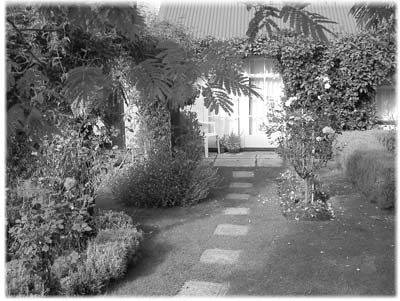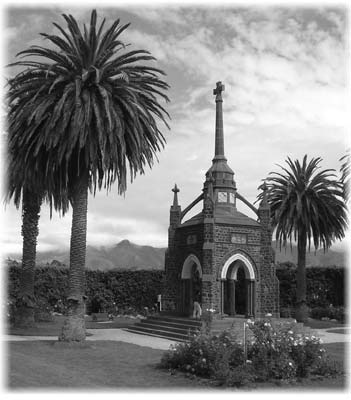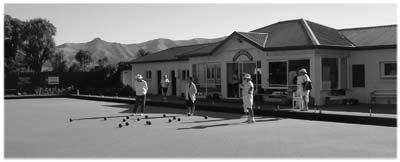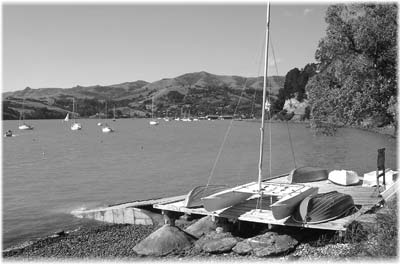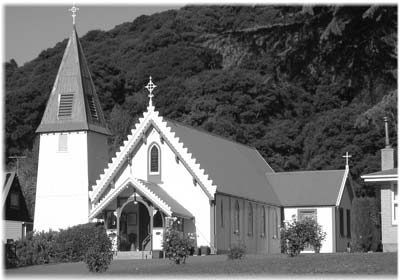New Zealand’s Akaroa
by Todd Vogel, Silverton, OR
In 2005, my wife, Pattie, and I flew from Portland, Oregon, to Los Angeles for our direct overnight flight to Christchurch, New Zealand, on Air New Zealand ($1,032 per person). We had 12 hours of relative calm and indolence, punctuated by drinks, snacks, drinks, washcloths, drinks, meals, drinks, candies and, of course, occasional turbulence.
Stepping off the plane in Christchurch, I was immediately struck at the simplicity of this airport — small yet complete, compact and efficient. This is a much more convenient airport than Auckland’s.
We were returning to the small, French-influenced village of Akaroa, called the Riviera of Canterbury (District), on the Banks Peninsula. There we’d do some deeper investigation into the local color — the scenery, the people and, especially, the food and drink. We traveled in March, one of the best months to visit New Zealand for the fewest number of tourists.
At first glimpse
At the airport we rented a compact car, a truncated Holden Cruze (National Car Rental — NZ$43 per day, with automatic transmission, air- conditioning and CD player, without supplemental insurance).
Akaroa was only 90 minutes from the Christchurch airport via Highway 75, driving through some lovely rolling farmland. Finally climbing the last major hill in our little, laboring (1.5-liter engine) car, we arrived at the breathtaking Hilltop Tavern lookout. We always look forward to the picture-postcard view of Akaroa Harbour, its shining turquoise water and the little encircling villages of Duvauchelle, Takamatua and Akaroa, situated on its eastern side. This day we weren’t to be disappointed, as we’d never seen this view more beautiful… and windy.
Akaroa Harbour is actually the result of a huge volcanic crater being penetrated by the sea at its south side. The resulting bay is oriented north-south and is surrounded by well-worn hills, with a crater-rim road leading down the opposite side to many lovely bays with fine-sand beaches.
On to Akaroa
Akaroa, our village destination, is but one vestige of several French influences in New Zealand. While the fearsome Ngai Tahu Maori tribe held sway here for over 800 years, it didn’t last — the Europeans were coming!
The first European-credited visit to the bay, around 1770, was made by Captain James Cook, who named the peninsula, which he mistakenly thought to be an island, after the naturalist Sir Joseph Banks. In 1838, French whaling captain Jean Langlois purchased (reputedly for a secret hollandaise sauce recipe) the peninsula from the Maoris, then returned to France.
He returned to Akaroa Harbour in 1840, hoping to establish a French settlement with 63 settlers. Apparently a few days late and a few francs short, they arrived only to find that the British had raised their flag over Akaroa, having “acquired” the land from the Maori chieftains as part of the Treaty of Waitangi. (The French, as well as Germans, did eventually settle here.)
As we drove down from the summit overlook, we decided to take a brief detour to the west side of the harbor and visit French Farm (phone +64 3 304 5784; www.frenchfarm.co.nz), formerly a French colony and now a charming winery and restaurant. After surveying their menu, we decided that their offerings weren’t comprehensive enough and headed off for our final destination, Akaroa.
Driving through the crossroads of Takamatua — up a hill and down again — we soon approached Akaroa and were struck once again by its beauty.
A taste of the good and the bad
Upon our arrival in town, a new and necessary café, By the Green (37 Rue Lavaud), called out our names. After a “flat white” coffee (espresso with a little milk) for me, a tea for Pattie and a piece of mouth-melting carrot cake for both of us (NZ$13.50), we were amply fortified.
We drove into town to look for our next several nights’ lodging, The Maples, a restored Akaroa home (c. 1850) on Rue Jolie (phone 03 304 8767; www.themaplesakaroa.co.nz). Its Garden Room, an artfully restored garden shed (NZ$120, or US$81, per night, with breakfast), was to be our home for the next four nights.
After our hosts, Lesley and Peter, greeted us warmly and showed us to our room, we walked down to the charming waterfront, with its cafés and general store, about four blocks away in the village. It had changed little since our last visit, save for a new one-way street going along the waterfront.
After all this exercise it was time for lunch, so we chose a small café overlooking the water, L’ Hotel. However, they told us that it was too late (about 3:30) for lunch and that we’d have to wait until 5:30 for dinner. Lucky we’d eaten something earlier!
We walked around and then went back for dinner. I ordered my perennial favorite, New Zealand green-lipped mussels. Pattie ordered a vegetarian dish, and we began what was to be a long wait. When our meals finally arrived, about 45 minutes later (and we were their first dinner customers seated), the mussels tasted like — and enjoyed the tenderness of — a baseball mitt. Pattie’s wasn’t much better.
Wiser but still hungry, we vowed never to return, only to find out from our B&B hosts that L’Hotel was considered by many to be the worst restaurant in town!
Some sightseeing
The next morning, refreshed and fed, we took the car up to Summit Road, which circumscribes the crater and allows for spectacular views and access to the eastern bays.
We started with Le Bon Bay and its caravan park, then continued on to Okains Bay and its charming little grocery store/gas pump, with friendly help and vital provisions (peanuts, apples, drinks and Magnum bars). It is also home to a reputedly great local history museum, but we didn’t go in.
We took, and we recommend that you take, the contour-following connecting road to Little Akaloa Bay through the seaside hills. It offers fabulous views and is even paved part of the way.
Approaching Little Akaloa Bay, we stopped to visit the small, century-old St. Luke’s Anglican Church, said to be the most exquisite in all of Canterbury. It’s built of concrete, iron sand and paua (abalone) shells, the interior carved in wood and stone; it is a sight to see. The surrounding cemetery bears mute witness to the generations of settlers who have carved out farms in this isolated part of the Banks Peninsula.
We drove down to the harbor, enjoying the magnificent views, translucent clear water and fine beach.
A night out
Reluctantly, as the sun retreated over the northern sky (think Southern Hemisphere), we drove back to Akaroa for our eagerly anticipated reservation at the acclaimed restaurant C’est la Vie (phone +64 3304 7314). What we found was a very small building with about eight tables and one waiter.
When we made our reservation, we were asked, “Would you mind sharing a table?” A famous gourmet restaurant with family-style seating? We said we’d prefer not to as this was a special occasion (I would be spending a lot for this food!). This probably accounted for our being seated at a 2-person table located next to the swinging door to the toilet.
We ordered the cheapest beers they had (bottled Speight’s at NZ$7 each) and proceeded to evaluate the menu. I opted for the venison, a specialty of New Zealand.
It was very well prepared, tender and delicious, it came with a few accompaniments (although most food in New Zealand is sold à la carte) and it was served in the copper pan in which it was cooked. And it cost only NZ$32 (US$22). Crikey! (You’re undoubtedly beginning to sense my frugality — my wife says “cheapskate” — regarding the prices in New Zealand.)
As the U.S. dollar has plummeted against most foreign currencies, on our trip the N.Z. dollar was worth about twice what it was just a few years before. I regularly suffered sticker shock.
Our dinner with two beers, no wine, no appetizers, a main course for each (Pattie had a vegetarian dish again) and no dessert came to NZ$73 (US$51). Fortunately, the 12.5% GST is usually included, as it was here, and tipping had yet to become mandatory. Not so in the cities, however.
Working up an appetite
The next day we decided we’d take a day hike up above Akaroa guided by some excellent hand-drawn maps that we purchased from the information center on the south side of town, opposite the War Memorial. It took us high above the town, through bush and pasture, and gave us some great views of the bay and village.
The weather during our entire visit was very temperate, about 70°-75°F, and this day was no exception. Nevertheless, I managed to perspire (my grandmother told me never to say “sweat”) profusely, and we had only one small bottle of water!
“Hurrying” back from our proposed 2-hour hike in only three hours, we stopped in town for lunch at another highly recommended restaurant, Ma Maison (6 rue Balguerie), on the waterfront — a much better choice this time. It had great views, great service and great food. Prices were, well, tolerable.
We enjoyed it so much and ate so well at lunch (beer, salads and desserts) that we went back for dinner. Still full, we opted for some homemade, toasted crusty breads and spreads (olive tapenade, hummus and basil) and some softer-centered rustic bread with three types of olive oils to sample. After ample portions, plus two ice-cold draft beers to finish off, we got out for under NZ$30 (US$21).
Prospective property
We’d always fantasized about a holiday home in New Zealand, so for the next couple of days we drove all over the peninsula looking at real estate. Be advised, the housing boom has hit here in a big way. Values were up over 20% from the previous year in Akaroa. A nice 2-bedroom cottage within a 10-minute walk of the village ranged from NZ$400,000 to NZ$700,000, or about US$300,000 to $500,000. So much for bargains.
Local entertainment
We enjoyed two different nights attending the new Akaroa movie theater, housed in a small, renovated building attached to the local school. It was a new facility, owned by a couple of entrepreneurial Americans, and had very commodious seats, air-conditioning and stadium seating. We saw two “artsy” films: “Maria Full of Grace” and “The Motorcycle Diaries.” Both are recommended.
The cost was NZ$11 each. It was a good value and good fun, and they served food and drink as well, though we didn’t indulge (still stuffed).
One last visit
Sadly, it was time to leave lovely Akaroa and move on to a rented apartment in Christchurch. But we returned to Akaroa a few days later on a day trip via the scenic route from Christchurch, traveling through Dyer’s Pass, Governor’s Bay, Gebbie’s Pass Road and Motukarara, connecting to Highway 75.
True to form, we stopped at our usual coffee/tea joint, had lunch at another excellent restaurant on the waterfront, Bully Hayes (try the char-grilled beef salad, NZ$17), and returned to Christchurch for the long journey home the next evening.
All in all, it was another great trip to that other “Land Down Under.”


